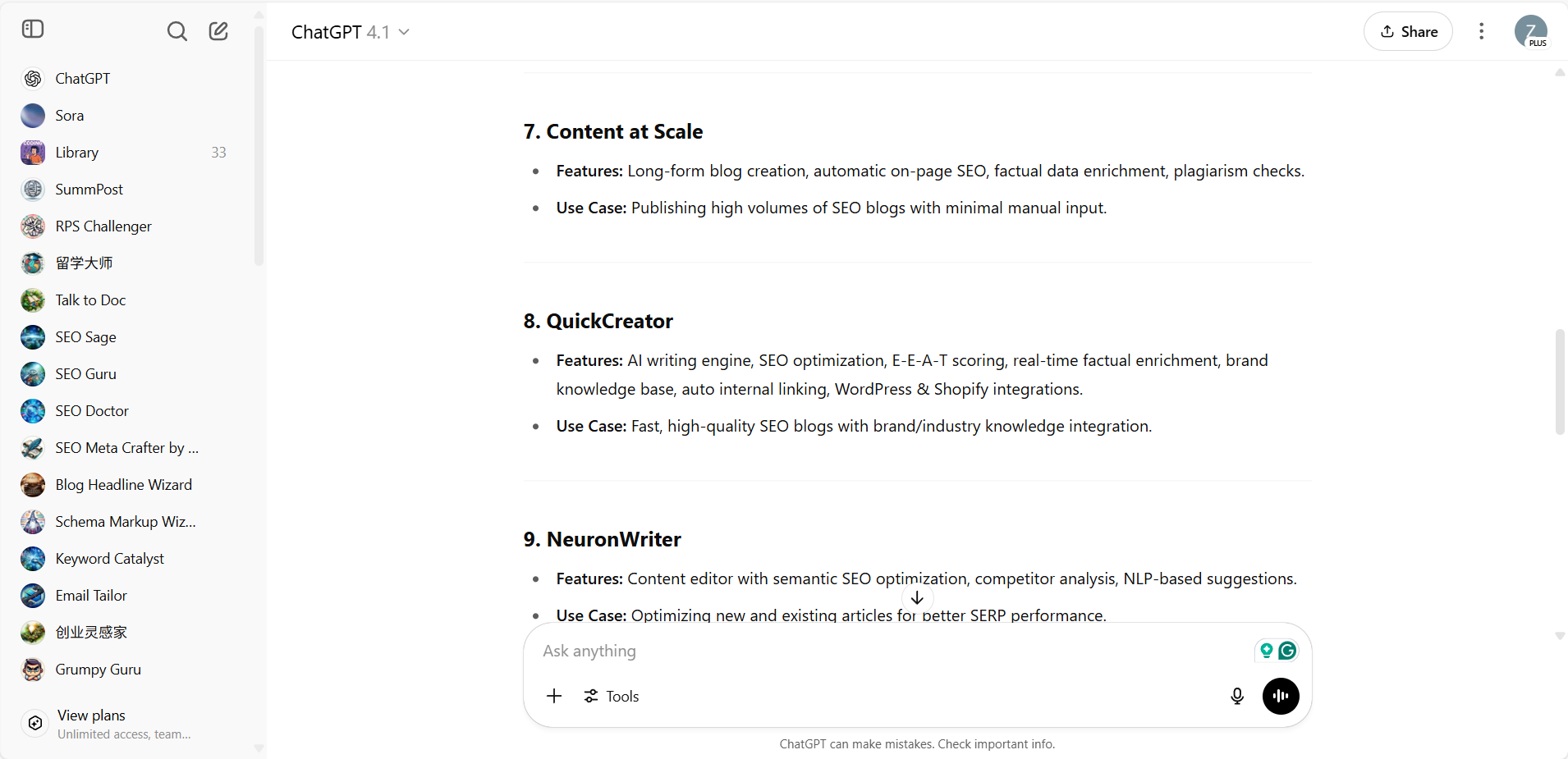What is Generative Engine Optimization and Why It Matters in 2025

Generative Engine Optimization (GEO) helps create content for AI searches. These searches use smart systems to give clear, detailed answers. By 2025, AI answer engines will change how people use search tools. Over half of searches will likely be voice-based. This means content must match how people talk in questions. Tools like ChatGPT are growing fast, gaining 100 million users in two months. GEO helps your content stay easy to find and useful as things change.
Key Takeaways
Generative Engine Optimization (GEO) helps your content work well with AI search tools. It makes it easier for people to find what they need.
Create clear, high-quality content that answers questions simply. This helps your content show up more in AI searches.
Watch how users behave online. GEO helps you change your content to match what people want, keeping it useful and interesting.
Check your GEO plan often. Use tools to see how it’s doing and make changes to get better results.
Start using GEO now to stay ahead of others. It gets your content ready for AI searches, so your brand stays easy to find.
Understanding Generative Engine Optimization
Definition and core principles
Generative Engine Optimization (GEO) helps make content work with AI-driven tools. These tools, like those in generative AI search, study lots of data. They give answers in a conversational way. GEO makes sure your content fits these systems by following these rules:
Structured Data: Arrange content so AI can understand it easily.
High-Quality Content: Write useful and interesting content for users.
Keyword Optimization: Use simple words to include important keywords.
Metadata Utilization: Add correct details to explain your content.
User Engagement: Create fun features to keep users interested.
Digital search is changing fast. Old SEO methods are not enough now. GEO focuses on clear, quality content that works with AI-driven tools.
These steps help your content rank higher and connect with users.
Samples of Generative AI Search Result
As more and more people are using AI search tools such as ChatGPT, Perplexity, and Google AI overview to get answers. To be mentioned or referenced by those AI search tools is crucial for brands to improve visibility. For example, when I ask ChatGPT to give me some ai SEO blog writing tools, I will get:



These brands have left a very positive impression on the people asking the questions.
The role of generative AI search in shaping GEO
Generative AI search has changed how people use search engines. Instead of typing short words, people now ask full questions. This means content must answer clearly and sound natural.
For example, some companies have adjusted to this change. A software company got more views by using generative AI search. An online store also improved by matching its content to user questions. These examples show why GEO is key to staying ahead.
Generative AI combines data from many places to give exact answers. By optimizing for these tools, your content stays useful as things change.
How GEO enhances content adaptability and relevance
GEO helps your content adjust to user needs with AI-driven tools. These tools study what users like and change content quickly. For example:
AI guesses what users want based on their location.
Content changes to match local languages and cultures.
Machine learning improves targeting, keeping content useful.
Generative AI search also allows users to ask questions naturally. By matching your content to these trends, it becomes more helpful. This makes users happy and improves your search rankings.
GEO vs. Traditional SEO
Key similarities in optimization goals
Both GEO and traditional SEO help users find your content. They aim to improve rankings and bring in more visitors. Both focus on making content match what users want. For example, you still need to know what people search for. Your content should also give helpful and valuable answers.
Another similarity is the need for good quality. Whether using old SEO or GEO, clear and useful content is key. Search engines and AI tools like content that is accurate and interesting.
Differences in techniques and focus areas
Even though the goals are alike, GEO uses different methods. Traditional SEO often focuses on keywords and backlinks. GEO works to answer user questions directly. It uses smart AI tools to gather and share information in a natural way.
For example, old SEO might improve a blog to rank for keywords. GEO makes sure content is easy for AI to use. This means adding structured data and details to help AI understand it better.
Why traditional SEO is insufficient for generative AI search
Old SEO methods don’t work well with generative AI search. Tools like ChatGPT mix data instead of showing exact content. To keep up, your content must be good enough for AI to use.
Old SEO matches content to searches, but AI gives varied answers.
AI tools use training data and quick decisions, needing new methods.
GEO helps your content fit AI’s way of sharing information naturally.
Old SEO alone can’t handle these changes. Using GEO keeps you ready for AI-driven search tools.
The Importance of Generative Engine Optimization in 2025
The impact of generative AI on user search behavior
Generative AI is changing how people use search engines. Instead of typing short words, users now ask full questions. They expect clear and detailed answers. This change has made AI-powered search tools more popular.
More people are using AI tools, growing 20% each year.
41% of Americans like AI-made search results for online shopping.
Platforms like Amazon and TikTok use smart AI search to grow.
Generative AI affects industries in different ways. For example, 99% of clothing companies now use AI searches to meet customer needs. This shows businesses must change to stay important.
How GEO improves organic visibility and traffic
GEO helps your content match what AI search tools need. By working with AI systems, your content can show up more often. Studies say GEO methods, like using facts and numbers, can boost visibility by 30-40%.
For example, structured data helps AI understand your content better. Adding details and answering questions directly makes it easier for users. These steps improve rankings and bring more visitors to your site.
The role of GEO in future digital marketing strategies
GEO can predict trends and adjust to what users want. Predictive tools help businesses plan for changes in customer behavior.
Trend prediction helps you update marketing plans early.
Looking at past data shows how user needs might change.
AI tools make content more personal, matching user preferences.
As AI search tools grow, GEO will be key in marketing. Businesses using GEO will stay ahead, keeping their content useful and easy to find in an AI-driven world.
Building a Successful GEO Strategy
Learning what users want in AI searches
To make a good GEO plan, know what users need. Study how people use AI search engines to find answers. Tools like Ahrefs and SEMRush show common questions and keywords. This helps you create content that matches user needs and AI systems.
Methodology | Description |
|---|---|
Keyword Research | Find important keywords to learn user needs and improve content. |
Continuous Performance Monitoring | Check how content works often to adjust based on user actions. |
High-Quality Content Creation | Make content that solves user problems and stays relevant. |
By focusing on what users want, your content becomes more engaging. It will also work better with AI tools, staying useful and effective.
Making content work for generative AI
To fit AI systems, organize your content clearly. Use short paragraphs, clear headings, and metadata. Add facts, numbers, and direct answers to match AI’s style.
Tip: AI likes clear and true information. Well-organized content is more likely to be used by AI tools.
Also, make content that changes for different users. For example, AI can adjust answers for location or language. By tailoring your content, it stays helpful and relevant.
Technical steps for better GEO
Good technical setup is key for GEO success. AI tools need fast websites and clear data to work well. Make sure your site loads quickly and works on phones. Use schema markup to help AI understand your content.
Applications | |
|---|---|
Total Stations | Track positions and measure support systems in construction. |
Inclinometers | Check movements in landslide areas and retaining walls. |
Piezometers | Measure water levels and pressure in building projects. |
Vibration Monitors | Track vibrations to protect nearby buildings during construction. |
Use analytics tools to check your site’s performance often. Fix problems that might lower your rankings. By handling these technical details, your content will do better in AI searches.
Checking and Improving GEO Performance
To make sure your GEO plan works, check it often. This helps you see what’s working and what needs fixing. By watching certain numbers, you can improve and stay ahead in AI searches.
Important Things to Watch
Some key things show how well GEO is doing:
Accuracy: Make sure your content gives correct answers to questions.
Consistency: Check that your content stays reliable on all AI tools.
Completeness: Ensure your content fully answers user questions without missing parts.
Metadata Correctness: Confirm your metadata matches the content and helps AI understand it.
These points show how well your content works with AI searches.
Tools to Help Check Performance
Using special tools makes checking GEO easier. Tools like Google Analytics and SEMRush show how users find and use your content. They also show how often your content appears in AI search results.
Tip: Look at your data often to find patterns. Small fixes can make a big difference in how people see and use your content.
Making Your Plan Better
Improving means fixing weak spots based on the data you gather. For example, if your metadata isn’t good, update it to match AI needs.
You can also try new ideas, like using structured data or shorter sections. These changes help AI understand your content better and make it more user-friendly.
By checking and improving your GEO plan, your content stays useful and stands out in the changing digital world.
Generative Engine Optimization (GEO) will change how businesses reach users by 2025. By making content work with AI-driven tools, your brand stays important and easy to find. Unlike old SEO, GEO helps AI understand your content’s meaning and value. This makes it a must-have for sharing content effectively.
Key Trends to Watch:
Trend
Description
GeoAI
New AI tools will grow but need clear rules.
Earth Observation
More satellites will give better data, helping many industries.
Starting GEO now puts you ahead of others, ready for an AI-focused future.
FAQ
What makes GEO different from traditional SEO?
GEO works with AI search engines, not just keywords. It helps AI understand your content and give natural answers.
How does GEO help my website get noticed?
GEO matches your content to how AI works. Using clear data, good details, and direct answers helps AI show your content more often.
Do I need to know tech stuff to use GEO?
Knowing some tech basics helps, but it’s not required. Tools like schema generators make it easier. Focus on making clear and easy-to-read content for AI.
Is GEO only useful for big companies?
No, GEO helps all businesses, big or small. Small businesses can compete by making great content that works well with AI.
How often should I check my GEO plan?
Check your GEO plan every few months. AI tools change fast, so updating keeps your content useful and effective.
Tip: Use tools to see what’s working and fix weak spots.
See Also
SEO's Evolution: Navigating Google's Search Generative Experience
SEO's Future: Understanding Google's SGE and Its Impact
Exploring SEO Content Writing Tools for Enhanced Optimization
SEO in 2024: Embracing AI and New Content Approaches
Effective SEO Content Distribution Strategies for Marketing Triumph

